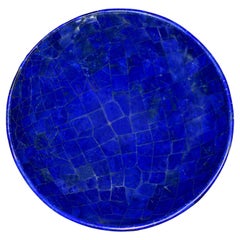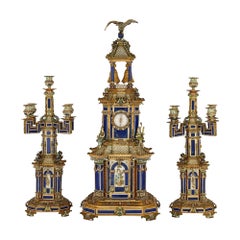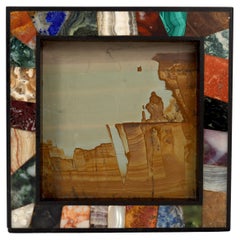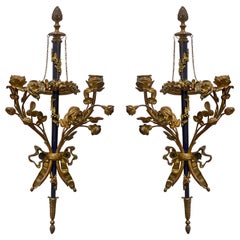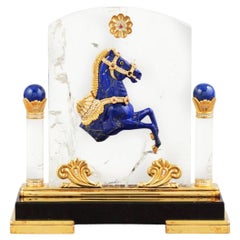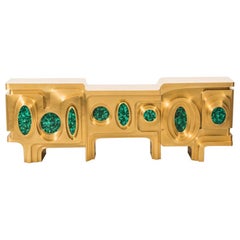Lapis Lazuli Furniture
2
235
108
12
to
31
186
130
355
294
311
29
27
20
15
14
7
5
3
2
2
1
1
1
1
12
75
148
120
26
34
40
2
2
4
2
8
8
14
4
355
344,681
294,346
203,951
142,002
187
112
68
66
48
13
7
4
4
3
Material: Lapis Lazuli
Finest Natural Lapis Lazuli Bowl 10"
Located in Somis, CA
This rare, stunning bowl is made of the highest quality natural lapis lazuli nature can produce. 100% natural, untreated, undyed, genuine stone. Of the rarest and most valuable, bril...
Category
2010s Afghan Lapis Lazuli Furniture
Materials
Lapis Lazuli
Impressive Antique Austrian Champlevé Enamel, Silver-Gilt and Lapis Lazuli Clock
Located in London, GB
Impressive antique Austrian champlevé enamel, silver-gilt and lapis lazuli clock set
Austrian, Late 19th century
Clock: Height 91cm, width 37cm, depth 37cm
Candelabra: Height 64cm, width 24cm, depth 24cm
Clock case: Height 97cm, width 44cm, depth 41cm
Candelabra case: 67cm, width 27cm, depth 27cm
Crafted in Austria in the late 19th century, this magnificent three-piece clock set was most likely gifted to the Imperial Russian family by the Austro-Hungarian Royal family. Its design is inspired by various cultures and styles, whilst its high quality celebrates some of the best craftsmen of the late 19th century.
Of a tiered pagoda shape, the clock is surmounted by an eagle, its wings spread wide landing atop a vibrant lapis lazuli ball. The eagle is most likely a reference to Turul, a mythological animal which is a symbol of Hungary. This bird of prey is also a popular feature within Turkish traditions.
Within a canopy, supported on four sturdy lapis lazuli pillars two prominent silver-gilt bells are hanging. These are carved with various motifs such as acanthus leaf design and connect to the clock mechanism below. The bells ring informing its users of the time.
All four sides of the piece are inset with a clock, an unusual feature on an object of this type and a testament to its highest quality. The inclusion of clocks on all sides signifies that the antique is aimed to be a centrepiece, admired from all sides. The dial is decorated using the champlevé enamelling technique, whereby ‘parcels’ are carved into the silver gilt and into which enamel is poured. The 12 numbers are coloured in black with a gold outline and are surrounded by a white circular background making them stand out and easy to read. The hour clock dial is cast in the form of a sun, while the minute hand is represented as the moon. The two motifs symbolise one’s bright and gloomy sides of existence.
The four corners around the clocks are mounted with three-dimensional female figures dressed in traditional garments from around the world. For example, one figure is dressed in typical Turkish clothing...
Category
Late 19th Century Austrian Antique Lapis Lazuli Furniture
Materials
Lapis Lazuli, Silver, Bronze, Enamel
Antique Grand Tour Pietra Paesina & Specimen Marble Rimmed Dish or Bowl
Located in Philadelphia, PA
A fine antique grand tour hardstone rimmed dish or bowl.
With a large central piece of Pietra Paesina (so called "ruins" marble).
The rim is set with various hardstone specimens, i...
Category
Early 20th Century Italian Grand Tour Lapis Lazuli Furniture
Materials
Lapis Lazuli, Malachite, Limestone, Marble
19th-C. French Neo-Classical Gilt Bronze and Lapis Sconces, Pair
Located in Kennesaw, GA
These are wonderful! This is a pair of French neo-classical revival gilt bronze sconces with lapis stems. The blue is wrapped with floral foliate and a garland of roses. They are in ...
Category
Late 19th Century French Neoclassical Revival Antique Lapis Lazuli Furniture
Materials
Lapis Lazuli, Bronze
Mellerio Paris, A French Gold, Diamond, Silver-Gilt, Rock-Crystal, & Lapis Horse
By Mellerio
Located in New York, NY
Mellerio Paris, A French Gold, Diamond, Silver-Gilt, Rock-Crystal, Obsidian & Lapis Horse
An extremely rare and unique, one of a kind French gold, diamonds, Silver-gilt rock-crystal, obsidian and lapis lazuli jeweled sculpture "Bucéphale, Chevaux de légende", "Bucephalus, A Legendary Horse" by Mellerio, Paris, circa 1998.
Sitting on black obsidian base, the solid rock crystal slab is finely applied with a lapis lazuli half-horse with harness mounted in 18k gold and brilliant cut diamonds, between two crystal and lapis lazuli columns adorned with gold and diamonds, insert with 7 ruby cabochons and 1 emerald cabochon, the obsidian base with a plaque engraved: CHEVAUX DE LEGENDE / MELLERIO DITS MELLER / PARIS / 5029 DIV
Bucephalus (c355-326 BC) is among the most famous horses in history, and it was said that this he could not be tamed. The young Alexander the Great, of course, tamed him – and went on to ride his beloved equine companion for many years and into many battles.
The piece is in excellent condition and comes with a custom made wood case made for transport. It's very elegant and has French hallmarks throughout. A truly magnificent piece.
Measures 10" high x 9" wide x 4" deep
Founded in France in 1613 by the descendants of Italian immigrants from the Vigezzo Valley in the north of Italy, Mellerio is one of the oldest jewellery houses in Europe. The family business soon attracted the attention of the Royal Court and Marie Antoinette herself reportedly purchased a precious bracelet featuring 7 cameos surrounded by rubies in 1780. Later on, in the 19th century, Mellerio became the official supplier of the French Royal family and the Court of Netherland.
Mellerio creates many jewellery items, all set with rare gems such as peridots, amethysts, aquamarines, citrines and topaz, applying for a patent, the flexible stem, a very supple and light jewellery mechanism. Mellerio remains also well known for their spectacular series of Art Nouveau jewels, created at the beginning of the 20th century, as well as for the creation of trophies rewarding some of the greatest footfall and tennis players of history. In 1993, the jewellery house launched their first watch collection.
Today, Mellerio has stores in Paris, Japan and Hong Kong.
July 14, 1789: this date is known throughout the world as the beginning of the French Revolution. According to a ledger belonging to House of Mellerio, this was also the day that the jeweler sold a golden key to the Comte de Coutance for 10 livres. This ledger, as well as inventories dating as far back as 1768, are the jeweler’s oldest archives. These archives have continued to grow over the years, as the House, established on rue de la Paix in Paris, still lives on today, still in the hands of the same family from Craveggia, in the North of Italy.
The tumultuous history of the Mellerio family in France probably goes as far back as the Italian wars of the Renaissance, but the first official document proving their commercial activity in Paris dates back to 1613. This document is the famous royal warrant awarded by Marie de Medici to a number of Italian families established along the rue des Lombards, including the Mellerios, allowing them to sell “small jewelery items”, therefore granting them a small exception to the traditional monopoly enjoyed by Parisian jewelers. At that time, powerful corporations regulated the operations and customs of Parisian business, but thanks to this exceptional warrant, the Mellerios managed to escape the confines of this framework. Today, this wax-sealed document is kept at the city hall of Craveggia.
From 1613 to the Revolution, the Mellerios lived between France and Italy. The corporations tried many times to put an end to their trade privileges, but all in vain, as a dynasty of sovereigns renewed the warrant. Always marrying and often retiring in Craveggia, the Mellerios continued to maintain their jewelry business in Paris. At first, they did this without a shop. Wearing backpacks (wooden boxes divided into small compartments where jewels were kept), they would tour town fairs around Paris and royal castles.
This is how Jean-Baptiste Mellerio (1765-1850) is said to have sold a bracelet set with rubies and Antique cameos to Marie-Antoinette, which still exists today. Many elements seem to prove the veracity of this anecdote. The queen was particularly fond of cameos, which cover the entire background of her famous jewelry cabinet, and ruby was her favorite stone after diamond. The famous bracelet, reacquired a few years ago by the House of Mellerio, is indeed an 18th century jewel, set with antique cameos representing the profiles of Roman emperors. Two branches of the family were operating in Paris during this time, under the reign of Louis XVI: that of Jean-François (1746-1828), the paternal ancestor of the current Mellerios, and that of Jean-Baptiste (1765-1850).
The French Revolution forced them to return to Italy. However, both Jean-Baptiste and François Mellerio (1772-1843), who was the son of Jean-François, were eventually able to return to Paris after the founding of the Consulate. Jean-Baptiste opened a shop at the Iron Crown of rue Vivienne, and François opened his at the Palais des Tuileries, rue du Coq Saint-Honoré. His well-organized order books give an idea of his high-ranking clientele during the “Old Regime”, among which were the Comte and Comtesse Octave de Segur, the Marquise (later Duchess) de Tourzel, former governess of the royal children, and her daughter, the Comtesse de Bearn, the Craufurds -who organized the flight to Varennes, the Duc and Duchess de Gramont, the Comtesse de Boigne, and Madame de Souza, Talleyrand’s mistress.
We also see the names of the imperial family: Empress Josephine, the Queen of Holland, Princess Elisa, Caroline and Pauline. At that time, the House of Mellerio specialized, among other things, in the trade of antique cameos, a newly fashionable genre of jewel that captured the imagination of all the princesses and noble women of the time.
The years of the Restauration and July Monarchy were among the most glorious. The Bourbons were back on the throne, and the clientele of the House of Mellerio had regained its former wealth. Mellerio supplied Louis-Philippe, Duke of Orléans, as well as his mother, wife and sister, with sumptuous jewels, including a set of emeralds made piece by piece, while the Duke of Bourbon, last prince of the House of Condé, offered diamonds to his mistress, the scheming Baronne de Feucheres, and Monsieur de LaFayette also bought cameos for one of his granddaughters. For the first time, Mellerio ventured into the world of arts in 1815, when Carlotta Grisi, a famous dancer who created Giselle, as well as an actress named Rachel, bought jewels at the Mellerio store on rue de la Paix.
1848 marked a new turning point. France once again became a Republic. François Mellerio handed the company over to his son, Jean, and the latter decided to travel to Spain to build a new clientele. He later became one of the jewelers of the royal family, and met Eugénie de Montijo, who remained a faithful client when she became empress of the French people. The Imperial years were lavish. During the Second Empire, Paris was a pageant of crinoline dresses designed by Worth, while jewels by Mellerio, Worth’s neighbour on the rue de la Paix, adorned the noble women of the Tuileries court.
The Empress bought pearls. Mathilde Bonaparte...
Category
20th Century French Lapis Lazuli Furniture
Materials
Lapis Lazuli, Rock Crystal, Gold, Silver
Vikram Goyal, Kohinoor Console, IN
By Todd Merrill
Located in New York, NY
Celebrated for his exquisite modern masterpieces that sit distinctly between furniture design and sculpture, New Delhi-based Vikram Goyal makes his debut with Todd Merrill Studio...
Category
2010s Indian Lapis Lazuli Furniture
Materials
Lapis Lazuli, Malachite, Brass
Lapis Lazuli, Rock Crystal and Doré Bronze Four Arm Sconces, E.F. Caldwell, Pair
Located in New York, NY
A very fine and unusual pair of Louis XVI Style E.F. Caldwell hand carved Lapis Lazuli, rock crystal, doré bronze and gilt metal four arm wall appliques/sconces. These are truly an e...
Category
1890s American Louis XVI Antique Lapis Lazuli Furniture
Materials
Lapis Lazuli, Rock Crystal, Bronze
Recently Viewed
View AllMore Ways To Browse
Blue Kitchen Cabinets
Beveled Glass Cabinet
Bedside Cabinet Drawer
Black China Cabinet
Black Chinese Cabinet
Carved Tall Cabinet
Book Cabinets With Doors
Wood Display Shelf
Bubble Pink
Chinese Glass China Cabinet
Wood Bedside Cabinet
Blue Tassel
Wall Of Kitchen Cabinets
Brazil Art Deco
Brazilian Art Deco
Cabinet With Drawer And Open Shelf
Bow Front French
Vintage Technologies
